Exploring the Guitar's Anatomy: the Critical Parts of the Guitar Every Player Should Know
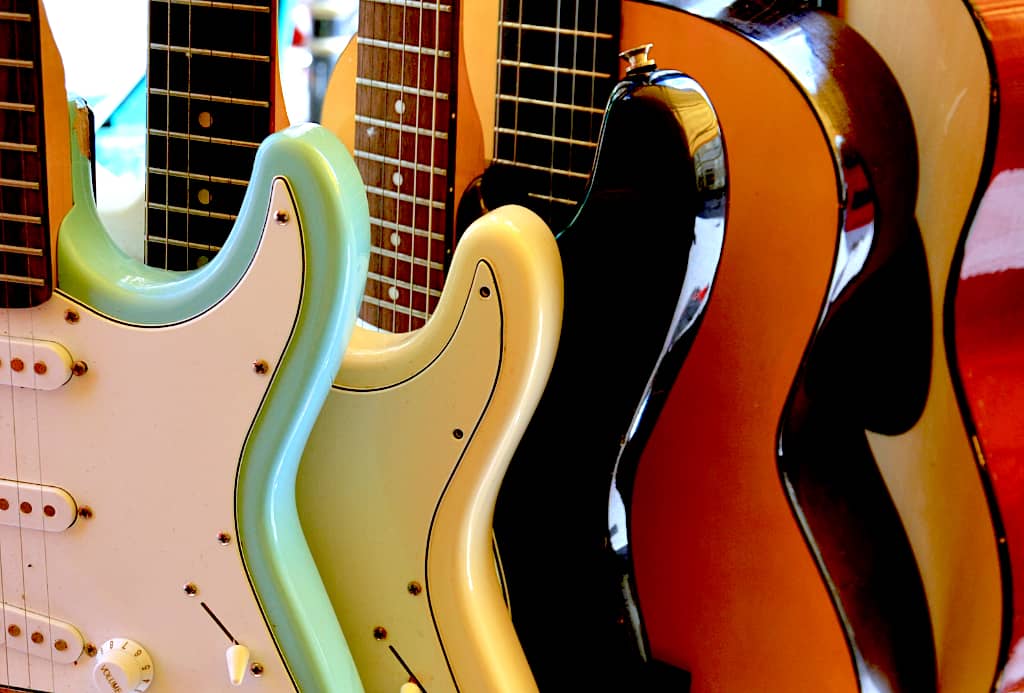
As a guitar player, it's essential to understand the inner workings of your instrument, whether you're wielding an acoustic or an electric guitar.
Familiarising yourself with the various components and their functions not only deepens your appreciation for the craftsmanship behind these iconic instruments.
Knowing the different guitar parts empowers you to make informed decisions when choosing, maintaining and playing your guitar.
We'll delve into the anatomy of both acoustic and electric guitars, discussing the importance of each part of the guitar and why every guitarist should be well-versed in the intricacies of their instrument to unlock your full potential and optimize playing experience.
The Parts of an Acoustic Guitar
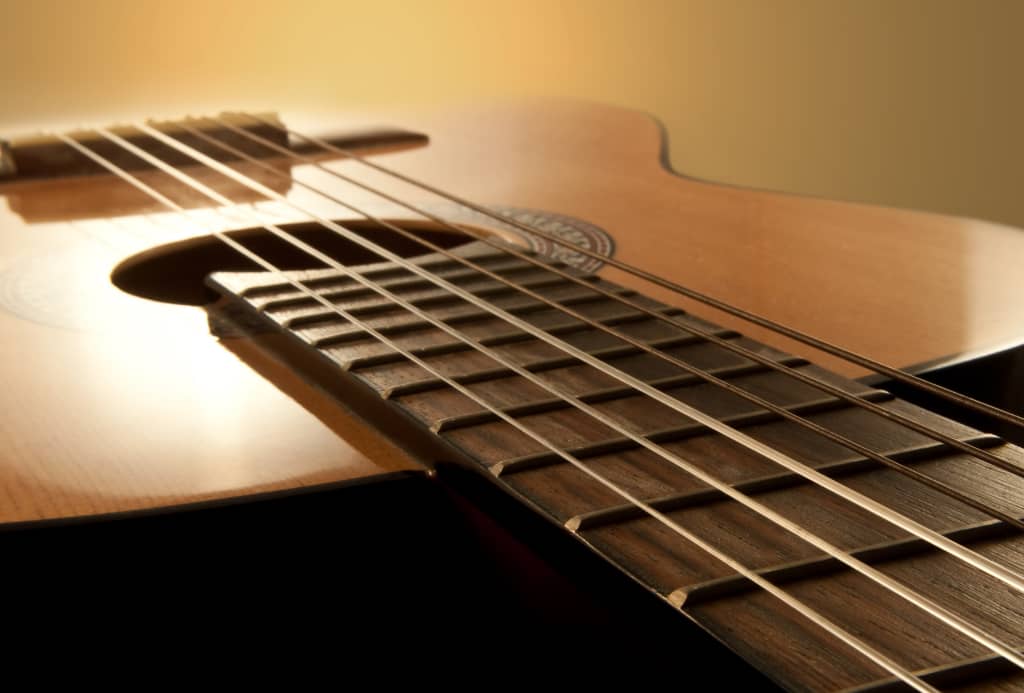
Understanding the anatomy of an acoustic guitar and the function of each component helps deepen your appreciation for the instrument and can significantly improve your playing.
From the soundboard and bracing patterns to the strings and neck construction, each part plays a critical role in shaping the guitar's sound, playability, and overall beauty.
With this knowledge, you can make more informed choices when selecting a guitar or caring for the one you already own, ensuring a lifetime of musical enjoyment.
Acoustic Guitar Body
Parts of an Acoustic Guitar Diagram
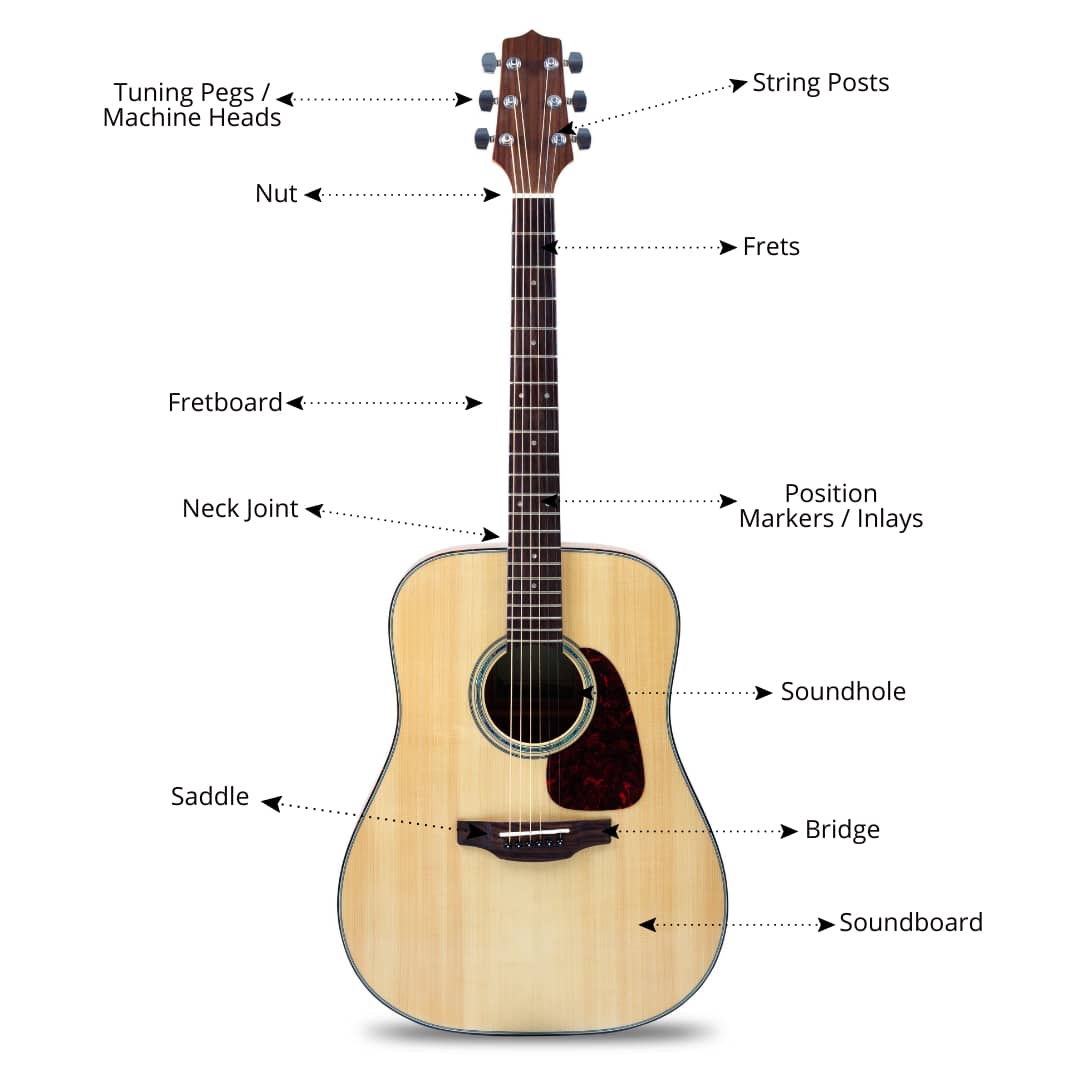
Soundboard (top)
The soundboard, also known as the top, is the front surface of the guitar's body.
It is typically made from spruce or cedar and plays a crucial role in the instrument's sound production.
When the strings vibrate, the soundboard amplifies the vibrations and projects the sound outward, making it audible to the listener.
Back and sides
The back and sides of the guitar are often constructed from hardwoods like mahogany, rosewood, or maple.
These components provide structural support and help shape the instrument's tone by reflecting sound waves generated by the vibrating strings.
Soundhole
The soundhole is an opening in the soundboard, usually circular or oval, located beneath the strings.
It allows the sound waves to escape from the body, contributing to the guitar's projection and overall tone.
Bridge
The bridge is a critical component that anchors the strings to the guitar's body.
It transfers the string vibrations to the soundboard, affecting the instrument's tone, sustain, and intonation.
Acoustic Guitar Neck
Fretboard (fingerboard)
The fretboard, or fingerboard, is a thin, flat piece of wood glued to the neck's front surface.
It's usually made from hardwoods like rosewood or ebony and has metal frets embedded along its length.
The fretboard is where the guitarist presses the strings onto the wood of the fretboard to play and guitar note and create different pitches.
Frets
Frets are thin metal strips embedded into the fretboard at specific intervals.
They divide the fingerboard into individual note positions, allowing the guitarist to play various notes by pressing the strings against the frets.
Position markers (inlays)
Position markers, or inlays, are decorative elements embedded in the fretboard, usually at specific frets (e.g., 3rd, 5th, 7th, 9th, 12th, 15th, 17th, 19th, and 21st frets).
They serve as visual guides for the guitarist to quickly identify fret positions.
Neck Joint
The neck joint is where the guitar's neck connects to the body, typically using a dovetail, mortise and tenon, or bolt-on construction.
The type of neck joint can affect the instrument's sustain, tone, and overall stability.
Acoustic Guitar Headstock
Tuning pegs (machine heads)
Tuning pegs, or machine heads, are mechanical devices located on the headstock that allow the guitarist to adjust the tension of the strings, changing their pitch to achieve proper tuning.
Nut
The nut is a small, hard piece of material (usually bone, plastic, or synthetic) located at the end of the fingerboard, where the headstock begins. It supports the strings, maintains proper string spacing, and plays a vital role in the instrument's intonation and tone.
String Posts
String posts, or string pegs, are part of the tuning pegs and hold the strings in place on the headstock.
The guitarist wraps the strings around these posts and tightens or loosens them to tune the instrument.
Acoustic Guitar Strings
Steel strings vs. nylon strings
Acoustic guitars typically use either steel or nylon strings.
Steel strings are more common on folk, country, and rock guitars and produce a bright, loud, and projecting sound.
Nylon strings, on the other hand, are primarily used on classical and flamenco guitars and generate a softer, mellower, and warmer tone.
String gauges and materials
String gauges refer to the thickness of the strings, which affects their tension, playability, and tone.
Lighter gauge strings are easier to play but may produce less volume and sustain, while heavier gauge strings require more finger pressure but provide a fuller tone and increased volume.
Strings can be made from various materials, including steel, nickel, bronze, phosphor bronze, and nylon, each contributing to the guitar's tonal characteristics.
Grab a new set of strings for your acoustic guitar HERE
Saddle
The saddle is a small, elongated piece of material (usually bone, plastic, or synthetic) that sits on the bridge and supports the strings.
It plays a crucial role in transferring string vibrations to the soundboard and affects the instrument's intonation, tone, and sustain.
Bracing (internal)
Role in structural support and tonal quality
The internal bracing of an acoustic guitar is a series of wood strips attached to the inside of the soundboard and back.
These braces provide structural support to the guitar, ensuring it remains stable and resistant to warping from string tension and environmental factors.
The bracing pattern also plays a significant role in the instrument's tonal quality by influencing the way the soundboard vibrates and responds to string vibrations.
Types of bracing patterns
There are several bracing patterns used in acoustic guitars, with the most common being X-bracing, fan bracing, and ladder bracing. X-bracing, often found in steel-string guitars, consists of two diagonal braces that intersect in the middle of the soundboard, forming an "X" shape.
This pattern provides a balanced tone and excellent structural support. Fan bracing, more common in classical guitars with nylon strings, features a series of braces that radiate out from the soundhole, resembling a fan.
This pattern allows for a more responsive soundboard and a warm, rich tone. Ladder bracing consists of horizontal braces running parallel to the soundboard's grain, providing a less complex and more focused sound.
The Parts of an Electric Guitar
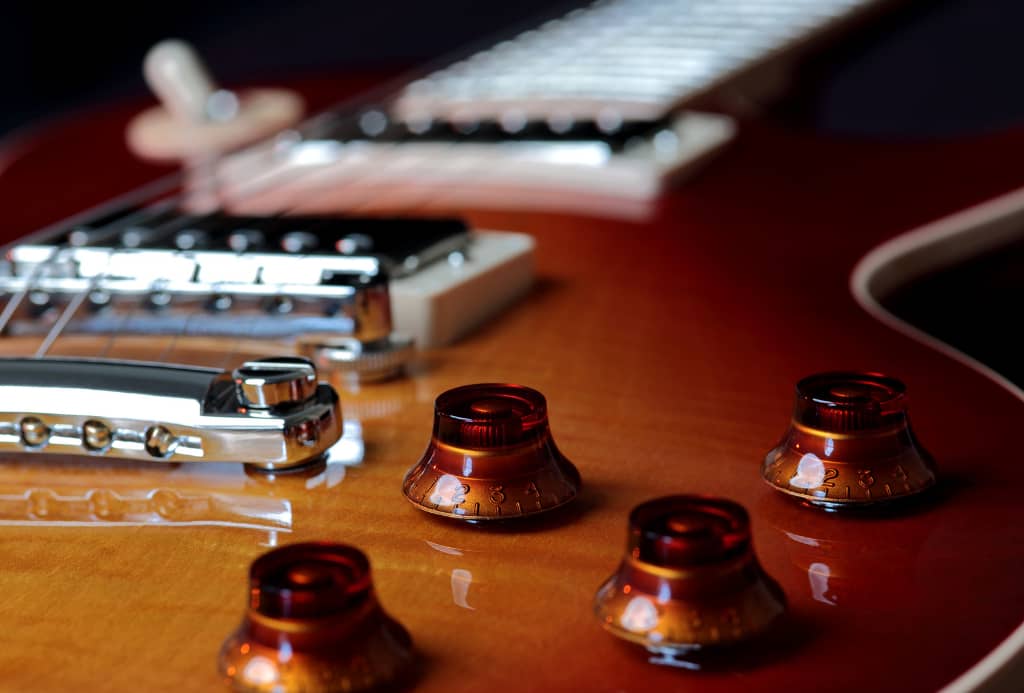
Electric Guitar Body
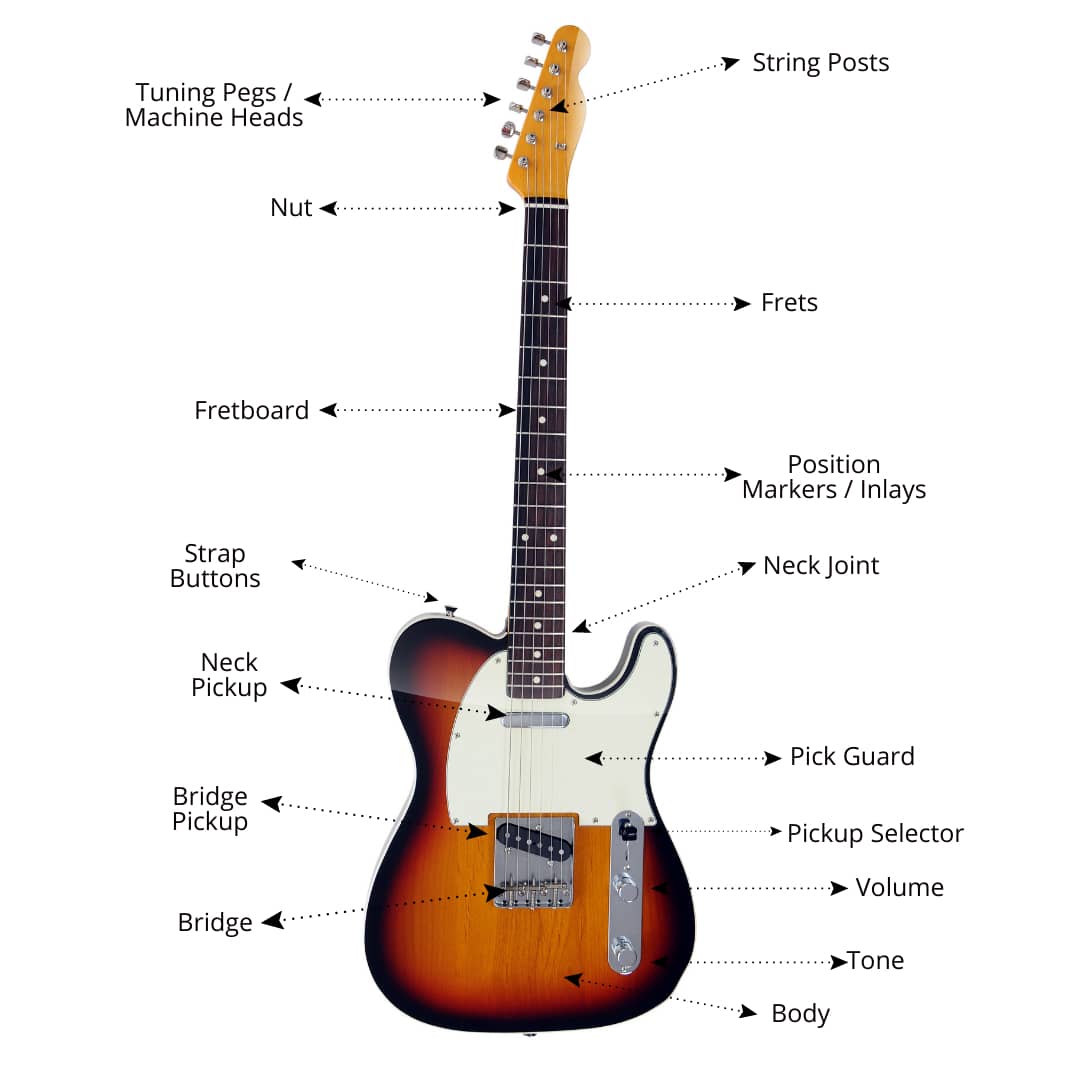
Solid body vs. semi-hollow body vs. hollow body
Electric guitars come in three primary body types: solid, semi-hollow, and hollow. Solid body guitars are made from a single piece of wood and provide excellent sustain and a more focused tone.
Semi-hollow guitars have a solid centre block with hollow chambers on either side, offering a blend of the solid body's sustain and the hollow body's warmth and resonance.
Hollow body guitars have a completely hollow interior, producing a more acoustic-like, warmer tone with increased resonance.
Pickguard
The pickguard is a thin, protective sheet of material (usually plastic) mounted on the guitar's body, below the strings.
It shields the guitar's finish from scratches caused by strumming or picking.
Bridge
The bridge anchors the strings to the guitar body and plays a vital role in the instrument's tone, sustain, and intonation.
Fixed bridges are non-movable bridges that provide a stable anchor point for the strings, contributing to better sustain and more stable tuning. Examples of fixed bridges include the Tune-o-Matic bridge and the hardtail bridge.
b. Tremolo (vibrato) bridges
Tremolo or vibrato bridges are movable bridges that allow the guitarist to alter the pitch of the strings by using a tremolo arm (whammy bar). Examples include the Floyd Rose, Bigsby, and Fender Synchronized Tremolo.
Electric Guitar Neck
Fretboard (fingerboard)
The fretboard, or fingerboard, is a thin, flat piece of wood glued to the neck's front surface. It's usually made from hardwoods like rosewood, ebony, or maple and has metal frets embedded along its length.
The fretboard is where the guitarist presses the strings to create different pitches.
Frets
Frets are thin metal strips embedded into the fretboard at specific intervals.
They divide the fingerboard into individual note positions, allowing the guitarist to play various notes by pressing the strings against the frets.
Position markers (inlays)
Position markers, or inlays, are decorative elements embedded in the fretboard, usually at specific frets (e.g., 3rd, 5th, 7th, 9th, 12th, 15th, 17th, 19th, and 21st frets).
They serve as visual guides for the guitarist to quickly identify fret positions.
Neck Joint
The neck joint is where the guitar's neck connects to the body, typically using a bolt-on, set-neck, or neck-through construction.
The type of neck joint can affect the instrument's sustain, tone, and overall stability.
Truss Rod
The truss rod is a metal rod embedded within the guitar's neck, providing reinforcement and allowing for adjustments to the neck's curvature or relief.
This is important for maintaining proper string action (the distance between the strings and the fretboard) and ensuring optimal playability.
Adjusting the truss rod can help to counteract the effects of string tension, humidity, and temperature changes on the neck's alignment.
Electric Guitar Headstock
Tuning pegs (machine heads)
Tuning pegs, or machine heads, are mechanical devices located on the headstock that allow the guitarist to adjust the tension of the strings, changing their pitch to achieve proper tuning.
Nut
The nut is a small, hard piece of material (usually bone, plastic, or synthetic) located at the end of the fingerboard, where the headstock begins.
It supports the strings, maintains proper string spacing, and plays a vital role in the instrument's intonation and tone.
String posts
String posts, or string pegs, are part of the tuning pegs and hold the strings in place on the headstock. The guitarist wraps the strings around these posts and tightens or loosens them to tune the instrument.
Electric Guitar Strings
String gauges refer to the thickness of the strings, which affects their tension, playability, and tone. Lighter gauge strings are easier to play but may produce less volume and sustain, while heavier gauge strings require more finger pressure but provide a fuller tone and increased volume.
Strings can be made from various materials, including steel, nickel, and cobalt, each contributing to the guitar's tonal characteristics.
Saddle
The saddle is a small, elongated piece of material (usually metal) that sits on the bridge and supports the strings.
It plays a crucial role in transferring string vibrations to the guitar body and affects the instrument's intonation, tone, and sustain.
Electric Guitar Electronics
Electric Guitar Pick Ups
Pickups are electromagnetic devices that convert string vibrations into an electrical signal, which can then be amplified and processed through an amplifier or effects pedals.
Single-coil pickups have a single coil of wire wrapped around a magnetic core, producing a bright, clear, and cutting tone.
However, they can be prone to picking up electrical interference, creating a humming noise.
Humbucker pickups have two coils of wire wrapped around a magnetic core, wired in such a way that they cancel out electrical interference. They produce a warmer, fatter tone with more output than single-coil pickups.
Active vs. passive pickups
Active pickups require an external power source (usually a battery) and incorporate a built-in preamp to boost the signal, resulting in a higher output and a more consistent tone across the frequency spectrum.
Passive pickups do not require an external power source and generally produce a more organic, dynamic sound.
Electric Guitar Controls
Volume and tone knobs
Volume knobs control the overall output level of the guitar, while tone knobs adjust the amount of treble or bass in the sound. Guitars often have separate volume and tone controls for each pickup, allowing for a wide range of tonal possibilities.
Pickup selector switch
The pickup selector switch allows the guitarist to choose between different pickups or a combination of pickups, further expanding the range of available tones.
Output jack
The output jack is the connection point between the guitar and an amplifier or effects pedals. It's typically located on the side or bottom edge of the guitar's body.
Electric Strap Buttons
Strap buttons are small metal posts attached to the guitar's body, allowing the player to attach a strap for playing while standing.
They are usually located at the base of the body and the upper bout or horn.
Need help with your Guitar Playing
I offer Live, online Guitar lesson! For more details CLICK HERE
Your Guitar Parts Questions answered
What are the guitar parts called?
I. Acoustic Guitar Anatomy
A. Body
1. Soundboard (top)
2. Back and sides
3. Soundhole
4. Bridge
B. Neck
1. Fretboard (fingerboard)
2. Frets
3. Position markers (inlays)
4. Neck joint
C. Headstock
1. Tuning pegs (machine heads)
2. Nut
3. String posts
D. Strings
1. Steel strings vs. nylon strings
2. String gauges and materials
3. Saddle
E. Bracing (internal)
1. Role in structural support and tonal quality
2. Types of bracing patterns
II. Electric Guitar Anatomy
A. Body
1. Solid body vs. semi-hollow body vs. hollow body
2. Pickguard
3. Bridge
a. Fixed bridges
b. Tremolo (vibrato) bridges
B. Neck
1. Fretboard (fingerboard)
2. Frets
3. Position markers (inlays)
4. Neck joint
C. Headstock
1. Tuning pegs (machine heads)
2. Nut
3. String posts
D. Strings
1. String gauges and materials
2. Saddle
E. Electronics
1. Pickups
a. Single-coil pickups
b. Humbucker pickups
c. Active vs. passive pickups
2. Controls
a. Volume and tone knobs
b. Pickup selector switch
3. Output jack
F. Additional Hardware
1. Strap buttons
2. Truss rod (also found in some acoustic guitars)
III. Similarities and Differences Between Acoustic and Electric Guitars
A. Body construction
B. Neck and headstock
C. Strings and string tension
D. Tonality and sound production
E. Playing techniques and styles
What are the 3 main parts of the guitar?
The three main parts of a guitar, whether acoustic or electric, are the body, neck, and headstock.
The body of the guitar serves as the foundation for the instrument's resonance and tone, with acoustic guitars featuring a soundboard, soundhole, and internal bracing, while electric guitars incorporate pickups and electronics.
The neck is an elongated piece of wood that connects the body to the headstock, housing the fretboard (or fingerboard) and frets, which are crucial for producing the desired notes when pressing the strings.
Lastly, the headstock is located at the end of the neck, and it houses the tuning pegs (or machine heads), the nut, and the string posts, which are essential for maintaining the guitar's tuning and string spacing.
Understanding these three main parts and their functions is crucial for any guitarist looking to improve their playing skills and overall knowledge of their instrument.
What's the hole in a guitar called?
The hole in an acoustic guitar is called the soundhole, and it plays a significant role in the instrument's overall tone and projection.
Located on the soundboard (or top) of the guitar, the soundhole allows air to move in and out of the guitar's body as the strings vibrate, amplifying and shaping the sound produced by the instrument.
The design and size of the soundhole can vary depending on the guitar's make and model, and it can influence the tonal characteristics and volume of the instrument.
Understanding the function of the soundhole is important for guitarists looking to explore the acoustic properties of their instrument and enhance their playing experience.
Beyond the soundhole's primary function, it also serves as an access point for maintenance and repair tasks, such as adjusting the internal bracing, fixing cracks, or replacing components like the endpin jack or pickups in electro-acoustic guitars.
Some guitar makers and players may customize the appearance of the soundhole by adding decorative rosettes or unique shapes, which can further personalize the instrument and showcase its craftsmanship.
In contrast, electric guitars typically do not have a soundhole, as their design relies on pickups and amplifiers to produce and project sound.
However, semi-hollow and hollow body electric guitars may feature f-holes or other soundhole designs to facilitate the resonance of the guitar's body and create a distinct tonal quality that blends the characteristics of both acoustic and electric guitars.



